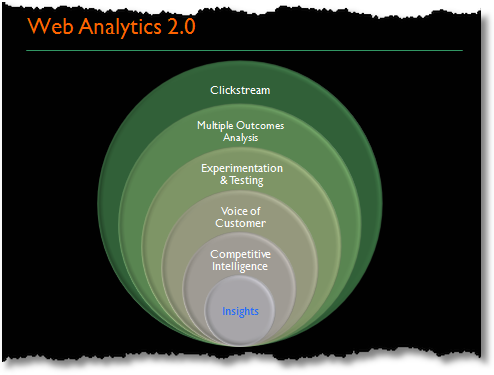
I had the pleasure of hearing Avinash Kaushik, Google's analytics evangelist, speak when he came to our CS377W class at Stanford this quarter (the "Stanford Facebook class"). He's an amazing speaker, really breathing life and purpose into the too-often dry topic of web analytics.
He's promoting a new way of looking at web analytics, what he calls "Web Analytics 2.0". Avinash'es central message is that analytics cannot stand alone as a decision driver in organizations; rather analytics need to be considered in the context of additional data (from customers, competitors, and other internal sources) in order to drive rational decisions.
Avinash has a brilliant decision framework, consisting of the five decision inputs that should be considered in order to gain insight into customer behavior and drive optimal decisions. He calls this "The Five Pillars" and here's the cliff's notes summary:
- Clickstream -- Typical web analytics can give you data on unique viewers, pageviews, session times, browser types, and geolocation.
- Multiple Outcomes Analysis -- The payload for most web analytics tools is goals/funnels and conversion rate analysis. Having clearly defined website goals is necessary and a great starting point, but not sufficient for true user insight. Analysts should recognize that users and companies may have many different reasons for visiting or hosting a website. All those objective outcomes need to be measured to see if the site is really driving the desired outcomes.
- Experimentation & Testing -- In it's simplest form, this means A/B testing the design of your website, including text, graphics, buttons, banner ads, everything. Some free tools like Google Website Optimizer actually automate the process of running multivariate tests to help you quickly find the optimal.
- Voice of the Customer -- Even after taking your best stab at Multiple Outcomes Analysis (#2, above) ask website visitors through surveys: (1) why are you here?; (2) were you able to achieve what you came for?; (3) if not, why not? The results can be tied back to analytics data and may reveal customers' true motivations.
- Competitive Analysis -- Your site does not exist in a vacuum. Your competitors may be running campaigns or launching products/features that are impacting your site's performance (could be either up or down).
An important theme that runs throughout Avinash'es comments but doesn't explicitly show up in his framework is:
- Analysts should not be the only people in an organization who see all this information. The process of gaining customer insight is becoming more and more automated and this information can and should be put into the hands of more people throughout each organization.
This is really, really powerful stuff -- everything I've seen in my experience at AlphaBlox, PayPal, and Slide confirms that (1) companies are hungry for this kind of analytically-driven insight; and (2) teams that really LIVE this analytical process are winners -- when people talk about "cracking the code" on how to continuously improve a web-based business, this is analytical process is really what they're referring to. The early PayPal team established a metrics-driven culture that did a good job at upholding the Five Pillars (though we didn't call them that at the time). And the Slide team is doing an awesome job at this, using a slightly different but equivalent analytics framework. The information is out there... Avinash does a great job packaging it up, now companies need to really internalize his message.
If any of this strikes a chord with you at all, you should do yourself a big favor and read Avinash'es entire post (and watch the video!) on this topic:
http://www.kaushik.net/avinash/2007/09/rethink-web-analytics-introducing-web-analytics-20.html
He's even got a primer at the bottom of his blog post on how to get started with this analytics methodology.
[...] Posts Porter's Five ForcesCialdini's Six Weapons of InfluenceAvinash Kaushik's Five Levels of "Web Analytics 2.0"Five Levels of Web-based Product [...]
ReplyDelete